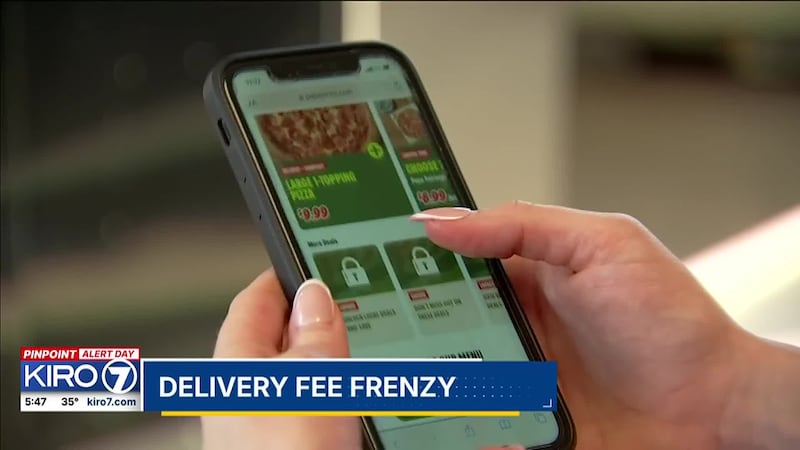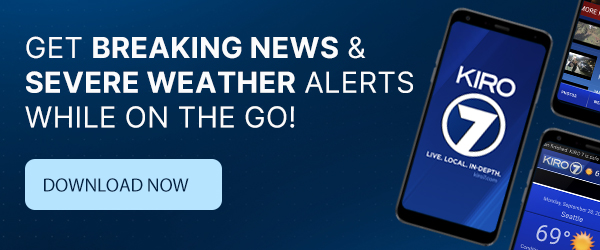Food delivery apps have transformed mealtime with unparalleled convenience and choices, but that ease comes with a hefty price tag. KIRO 7 is comparing the three heavyweight apps to see how you can save the most!
Food delivery apps have everything you want at the push of a button – endless options at your fingertips at all hours, and Americans cannot get enough.
The average American spends an eye-popping $1,850 on food delivery every year, according to a recent Circuit study.
The choice? Uncanny!
The convenience? Unparalleled!
The cooking and cleanup? Unnecessary!
The cost? Unaffordable.
“These fees are astronomical,” said Jeff Shulman, a marketing professor at the University of Washington Foster School of Business.
Among the extras? A service fee, a delivery fee, a City fee (like the $5 charge that companies have tacked on to offset Seattle’s local laws), a small order fee if you don’t spend enough, a distance fee for if you are too far from the restaurant – and of course taxes, and tip.
Add it all up, and just like that, the app has killed your appetite.
“Honestly, they’re way too high,” said Lindsey Walker, a delivery app avoider. “I’m paying double what I would pay if I were to just go and walk in the restaurant to pick up the food myself.”
Double the cost, but consumers continue to double down on orders. According to the 2025 Food Delivery App Report, the food delivery industry is expected to grow to $213 billion by 2030.
“People are willing to pay for convenience,” Shulman said.
Shulman’s hot take on what is likely a lukewarm meal? The apps structure the fees the way they do to maximize profit.
“Why are these delivery fees so complex? Well, the answer is simple,” said Shulman. “The more complex the pricing is, the more difficult it is for you, as a consumer, to compare across options.”
Basically, finding a ‘deal’ is hard. So, KIRO 7 decided to run a little experiment to try to make it easy.
Our first step, purchase four orders from four restaurants in three cities (Everett, Tacoma, Seattle) to figure out how much each order should cost coming directly from the restaurant after tax.
A footlong turkey sub at Subway cost $13.89.
A quarter-pounder meal and a Happy Meal from McDonald’s, $19.07.
A large pepperoni pizza from Papa Johns, $24.24.
And a family meal deal from Panda Express, $38.62.
We entered those same orders into three apps — Uber Eats, Grubhub, and DoorDash — for each of the three cities (pricing varies by city and so do the fees).
From here, we were able to do a comparison to see just how much more you are paying to order on the apps.
You already know you are paying a premium, but brace yourself here.
In Everett, you’re eating an extra 53% on average.
In Tacoma, you’re treated to a 57% average upcharge.
And at a whopping 79% average markup, things are not-so-savory in Seattle.
Oh, by the way, these averages are before tip. NerdWallet recommends 15-20% for that.
How did we do our experiment?
To do this, we found the percentage premium for every order over the restaurant price (the restaurant price was adjusted to reflect current prices in both Everett and Tacoma) and then found the average. The percentage premium range before we took the average is as follows: 29-83% in Everett, 33-94% in Tacoma, and 58-110% in Seattle.
Findings in Everett:
In Everett, Grubhub was the most expensive for both family meals (the pizza and Panda Express). The same was true for Tacoma.
Also in Everett, Grubhub had the lowest markup on both small orders (McDonalds and Subway).
Findings in Seattle:
In Seattle, Uber Eats was the most expensive for all four orders, with markups ranging from 74% at Papa Johns to 110% at McDonalds.
DoorDash was the cheapest in Seattle, except for the smallest order (Subway) with Grubhub.
Findings in Tacoma:
In Tacoma, DoorDash was consistently the cheapest, except for the smallest order (Subway) with Grubhub.
Uber Eats was the most expensive for both small orders (McDonalds and Subway).
Best Prices by App:
The obvious money saver? Avoid the apps altogether – and order directly from the restaurant like we did.
Keep in mind that the item price listed on the apps is usually higher than the price listed at the restaurant. Shulman said this is one way the restaurants can offset the costs they pay to use the app – essentially pushing it onto the customer. The average price markup on each app was 20-25% higher on any given item than from the restaurant directly.
If app avoidance isn’t an option, compare prices from app to app.
In our little smorgasbord tasting, Uber Eats was the most expensive in all three cities. DoorDash was consistently the cheapest.
On the delivery front, DoorDash offered the most promotions/discounts, and Uber Eats was the cheapest – but both companies charge extra for long distances, so if you live far away, go for Grubhub.
The service fee is where things really start to add up! DoorDash charges a flat 15% or $3 minimum, so that will work in your favor for orders in the $20 to $100 range.
Single-item, low-cost orders like our Subway sandwich had the highest markups of anything across all three apps (59-83% in Everett, 72-94% in Tacoma, and 85-100% in Seattle). The cheapest app for the small Subway order was Grubhub in every city.
So, if you need something under $10, our experiment suggests Grubhub is a good place to start.
Professor Shulman believes the fees still have room to go higher, before ultimately hitting a breaking point.
Until then, hopefully, you can use these nuggets of wisdom to help make your next meal, a happier one.
KIRO 7 reached out to each of the delivery apps involved in our experiment, a statement and link to each app’s fee structure/breakdown can be found below.
Uber Eats:
“When you place an order, the fees you may pay cover delivery and platform costs, so your order arrives quickly and reliably. Consumer-facing fees are transparently disclosed to customers prior to placing an order on the Uber Eats platform so that they can make informed decisions about the price and value of their order before placing it, and are also displayed on a consumer’s receipt. This transparency assures that consumers make an informed choice whether to order food from a restaurant using a third-party platform.
It’s important to note that merchants are in full control of the prices of their menu items on the Uber Eats app. Some merchants choose to increase their menu item prices on Uber Eats and other delivery platforms vs their in-store menu prices.
All-in, the prices consumers pay for orders from Uber Eats isn’t just the value of the item—they are paying for a service that allows them to browse merchants, place orders with just a few taps, and have them delivered reliably to their doorsteps.” – Uber Spokesperson
Click HERE for Uber Eats fee breakdown.
Grubhub:
“We do our best to keep fees as low as possible while covering the costs of handling delivery logistics, providing our technology to merchants and drivers, and making sure our delivery partners are paid fairly. We are upfront about our fees and clearly disclose them to customers during the checkout process.” – Grubhub Spokesperson
Click HERE for Grubhub’s fee breakdown.
DoorDash:
“Fees help us operate the DoorDash platform, as well as pay Dashers fairly, offer merchants tools to grow their businesses, provide customers with exceptional service and support, and build advanced safety and fraud features to help keep all users safe. In Seattle, we implemented a regulatory response fee of $4.99 on marketplace orders to help offset the cost of the City’s minimum pay ordinance. As we’ve repeatedly told city leaders, we would be able to reduce this fee if that law were reformed.” – DoorDash Spokesperson
Click HERE for DoorDash’s fee breakdown. DoorDash also has a transparency webpage.
©2025 Cox Media Group








